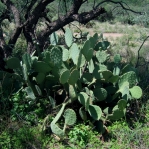
Griffiths, Annual report Missouri Botanical Garden 20: 90, 1909
Holotype; Topotype; Herbarium (as O. engelmannii); Painting
Original Description
What is Opuntia canada?
Opuntia canada is a large, erect, ascending cactus that grows in far southern Arizona. It is a compact-appearing prickly pear.
Details
O. canada grows in thickets or singly. This Opuntia may reach 1 m in height, but taller plants are known. It may be a bit wider than tall. It has ovate or obovate cladodes approximately 16 by 22 cm. But cladodes are variable in size, especially when young. Areoles are brown when young but turn black. However, they often retain a brown center because new wool continually develops in the center of the areole. Spines may not be present till cladodes are two-years-old, but then they may be conspicuous. Spines are variable but are commonly yellow when young bleaching to white. There are (1)2-3(5) spines per areoles, about 12-15 mm in length. They increase in number and length on older growth. Overall, there are fewer spines per areole than in O. engelmannii.
The flowers are yellow but may be tinged with reddish or orange on the bases of the inner tepals. The style is white or white tinged with red. The stigma is bright green. Fruit may be light red or mottled yellow and red. Seeds are flat but thick and angular, 3-3.5 mm in diameter with a prominently notched hilum.
Ploidy is unknown.
Other Notes
O. canada shares some similarities with spiny forms of O. laevis; however, the two species are consistently different. For instance, O. laevis grows on canyon walls or the rubble at the base, whereas O. canada grows in deeper soils, often on canyon floors. O. laevis has longer and more narrow cladodes. Also, O. laevis has hairy seedlings and longer fruits, whereas O. canada has naked seedlings and shorter fruits.


After searching through the various species, I believe this is what I have. I would love to share a picture to confirm!
Hi,
You can send a picture to [email protected]. We will try to ID it for you.
Joe Shaw